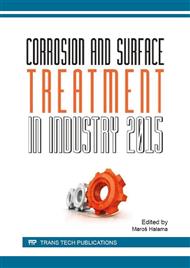p.146
p.153
p.159
p.167
p.172
p.177
p.181
p.187
p.193
The Influence of LPPS Process Parameters on Porosity and Microstructure of MCrAlY Coatings
Abstract:
In present article the influence of Low Pressure Plasma Spraying (LPPS) process parameters on microstructure of MCrAlY coatings was studied. Nowadays the Atmospheric Plasma Spray (APS) is the most widely used process to obtain MCrAlY-type coatings. The LPPS process may be consider as an alternative technology for deposition of this type coatings which have less porosity and smaller amount of oxides compared to APS coatings. This features are important to obtain coatings with better hot corrosion and oxidation resistance. In order to determine and optimize the process parameters the microscopic investigations were carried out. Assessment of microstructure, thickness of coating and porosity level was conducted as well. Correlation between LPPS parameters and obtained microstructure have been found. It has significant meaning for deposition of MCrAlY coatings which could be applied as a bond coat in thermal barrier coating (TBC).
Info:
Periodical:
Pages:
181-186
Citation:
Online since:
March 2016
Authors:
Keywords:
Price:
Сopyright:
© 2016 Trans Tech Publications Ltd. All Rights Reserved
Share:
Citation:


